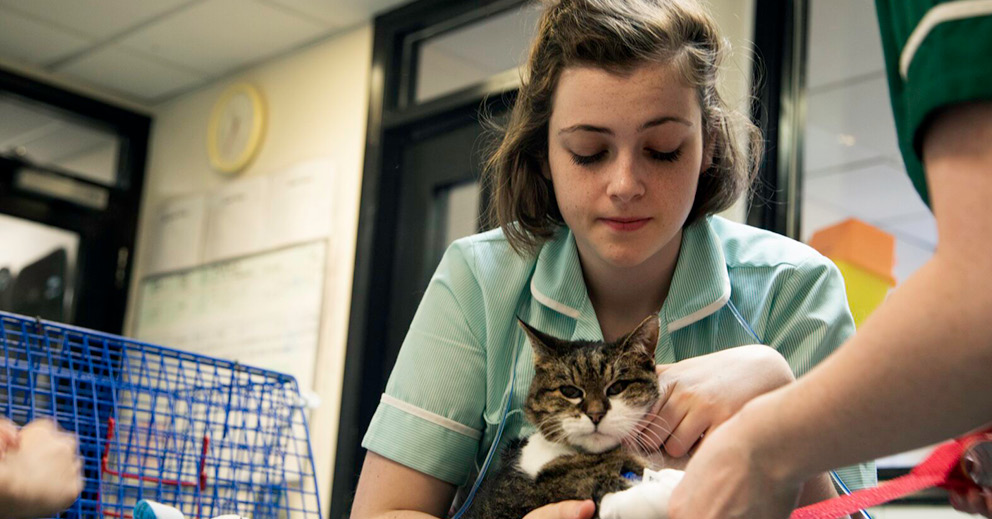
We have recently introduced a new, three-year training option for those who wish to study the Level 3 Diploma in Veterinary Nursing (Companion Animal), but who are not employed in an RCVS approved veterinary practice.
Whether you’re looking to change careers but are unable to find a position as a student veterinary nurse in your local area, or you’re a school leaver looking for an alternative to university, this new training option could be for you.
Here, we’re exploring our training route for non-employed applicants in further detail. Read on to find out how it works, who it’s for, where you can study and discover all the added features and benefits…

How does the programme work?
Students who are not employed in a veterinary practice will study the Level 3 Diploma in Veterinary Nursing (Companion Animal) over three years.
In years 1 and 3, you will undertake lessons on a day release basis either by coming into college for classroom tuition, or by studying remotely via online lessons in our virtual classroom (depending on which centre you choose to study from). In addition, you will be required to spend one additional day per week working through online course materials with up to a further six hours per week developing your practical skills using a virtual reality headset. When you are not undertaking college lessons, online learning or practical skills training in years 1 and 3, you are able to undertake casual work (working in any type of employment) to financially support yourself during the programme.
During year 2 of the programme, you will undertake a full-time unpaid work placement in an RCVS approved veterinary practice. You will undertake 40 hours per week for 45 weeks of placement across the 52 weeks.
Practical training sessions are held in-centre in the college environment; you will attend your chosen centre for practical training days (approximately 10) throughout your programme. We deliver this programme from centres located throughout the UK, including: Basildon, Bodmin, County Durham, Derby, Chorleywood, Edinburgh, Guernsey, Horsham, Huntingdon, Leeds, North London, Solihull, Wigan and Stoke-on-Trent. Find your nearest centre
Successful completion of the programme will allow you to apply to join the RCVS Register for Veterinary Nurses and use the post nominals, RVN.

Who is this programme for?
This programme has been designed to offer an alternative training route for those who would like to train as a veterinary nurse, but who have not been able to secure a paid position as a student veterinary nurse in veterinary practice. This course may be suitable if you’re unable to find a student veterinary nurse position or apprenticeship vacancy in your local area, or you’re looking for an alternative to University that doesn’t require 4-5 years of study or living on campus.

Why study this programme?
Studying our new three-year programme as a non-employed student can be an excellent alternative to university or an apprenticeship, and comes with lots of unique benefits.
✓ No employment required to apply
You do not need to be employed in a veterinary practice in order to apply for the programme. However, work experience undertaken in a veterinary practice alongside a reference from a veterinary surgeon or registered veterinary nurse supporting your suitability for veterinary nurse training will be a distinct advantage.
If you have not undertaken any work experience, we will consider your application, however you will be required to undertake work experience within the first three months of being on programme in order to make sure that this is the career for you. Assistance is available from the College to support applicants seeking work experience. You can view the full entry requirements on our website.
What’s more, the minimum age requirement to study the non-employed route is just 18, meaning if you’re a sixth form leaver you can start studying straight away!
✓ Study around your existing commitments
When you are not undertaking college lessons, online learning or practical skills training in years 1 and 3, you are able to undertake casual work (working in any type of employment) to financially support yourself during the programme.
✓ Support in finding a work placement for year 2 of training
Our dedicated placement team will use connections with over 700 veterinary practices to source an unpaid placement for your second year of training.
✓ Environmentally friendly education
If you choose to complete your weekly lessons remotely in our virtual classrooms, you will only need to attend your local satellite centre for approximately ten days per year for practical training sessions, minimising travel time and costs and reducing your carbon footprint. Many of our satellite training centres are located inside modern veterinary environments, with state-of-the-art facilities and specialist staff. Find your nearest centre
✓ Four intakes per year
Diploma students can qualify as a veterinary nurse in just 3 years, meaning the programme could be the perfect route if you are perhaps not in the position where you can take the four to five years of study necessary to gain a degree. More than this, if you find paid employment as a student veterinary nurse within your first year of training, you may be able to transfer to our programme for employed students in year two.
Whilst traditionally many training programmes begin in the autumn, you don’t need to wait until September to start your course. Non-employed students studying the diploma can begin their programme throughout the year, with intakes starting in January, April, July and October.

What other features do non-employed students benefit from?
Virtual reality
We are the first veterinary nursing college to integrate the use of virtual reality into veterinary nurse education. As a student on the non-employed route, you will be able to practise the OSCE tasks that you may come across in your real exams using a virtual reality headset, such as taking x-rays, packaging samples and identifying parasites. A team of developers have meticulously designed the software to simulate various scenarios covering both small animal and equine tasks used in OSCE examinations. The software not only teaches you the steps required to successfully pass each task, it also provides you with the ability to undertake mock tests and see how you perform, highlighting to you any steps you may have missed, to help with future learning. You can watch a sample task from our VR clinical skills environment on Youtube.
Find out more about Virtual Reality at CAW
Virtual Learning Environment (VLE)
We have recently launched our new advanced Virtual Learning Environment (VLE) which students will have access to 24/7. The new, web-based system delivers interactive learning materials to any connected device and allows students to submit assignments, take exams and track their assessments. Our VLE includes lots of exciting features to enhance our students’ learning, including a document repository, online exams and assignment submissions capability, VLE and IT helpdesk support, bespoke interactive learning materials developed in-house, lesson capture, virtual classroom delivery, forums, Microsoft 365 integration and eLibrary integration.
Live Online or college attended study options
If you choose to complete your weekly lessons remotely in our virtual classrooms, you will benefit from our Live Online learning provision, which combines the structure of a traditional classroom with innovative virtual learning. This is ideal for those who like the advantages of live classroom learning, but are unable to attend a CAW training centre due to travel constraints or family commitments.
Our online conferencing system allows our tutors to deliver effective teaching sessions and share engaging audio, video, slides, chats and screens. The software also offers lots of interactive features which means you can engage with your tutors and peers in real-time, for example through sharing of emoji icons, polling, and breakout rooms. Find out more about Live Online
There are also options to complete your weekly lessons from training centres located in Huntingdon, North London, Leeds or Basildon for selected intakes. Our training centres are easily commutable by car or public transport, and all feature a practical skills room and relaxation areas; along with modern lecture rooms complete with video conferencing facilities.
Flexible payment options
Veterinary nurse training doesn’t need to break the bank, and we offer a range of flexible payment options to help cover the cost of training. You can cover the course fees in one payment, pay annually, or break down the cost into monthly payments via our Pay-As-You-Learn scheme. We also offer the CAW Loans2Learn scheme, which can be used to fully or partially cover your course fees (but does not cover any Awarding Body fees). In addition, if you are over 19 years of age, you may be eligible to apply for an Advanced Learner Loan to help fund your studies (England only). Find out more about fees and finance

Where can you study the non-employed option?
We deliver this programme from centres located throughout the UK, including: Basildon, Bodmin, County Durham, Derby, Chorleywood, Edinburgh, Guernsey, Horsham, Huntingdon, Leeds, North London, Solihull, Wigan and Stoke-on-Trent. Find your nearest centre
Start your application for veterinary nurse training today
If you’re inspired to start your veterinary nurse training, we are enrolling for our next intakes now, and you can begin your application at any time by applying online. Alternatively, if you would like to find out more, or you have any questions about training with us, you can join us at one of our upcoming Open Evenings, or reach out to our Client Advisor team by calling 01480 422060, emailing admin@caw.ac.uk, starting a live chat on our website or requesting a call back.
